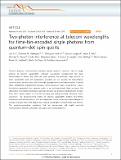Files in this item
Two-photon interference at telecom wavelengths for time-bin-encoded single photons from quantum-dot spin qubits
Item metadata
| dc.contributor.author | Yu, Leo | |
| dc.contributor.author | Natarajan , Chandra M. | |
| dc.contributor.author | Horikiri, Tomoyuki | |
| dc.contributor.author | Langrock, Carsten | |
| dc.contributor.author | Pelc, Jason S. | |
| dc.contributor.author | Tanner, Michael G. | |
| dc.contributor.author | Abe, Eisuke | |
| dc.contributor.author | Maier, Sebastian | |
| dc.contributor.author | Schneider, Christian | |
| dc.contributor.author | Höfling, Sven | |
| dc.contributor.author | Kamp, Martin | |
| dc.contributor.author | Hadfield, Robert H. | |
| dc.contributor.author | Fejer, Martin M. | |
| dc.contributor.author | Yamamoto, Yoshihisa | |
| dc.date.accessioned | 2016-01-19T15:10:03Z | |
| dc.date.available | 2016-01-19T15:10:03Z | |
| dc.date.issued | 2015-11-24 | |
| dc.identifier | 240146297 | |
| dc.identifier | 3b108b45-eae9-402d-b51f-db802a2c175e | |
| dc.identifier | 84947967917 | |
| dc.identifier | 000366380800002 | |
| dc.identifier.citation | Yu , L , Natarajan , C M , Horikiri , T , Langrock , C , Pelc , J S , Tanner , M G , Abe , E , Maier , S , Schneider , C , Höfling , S , Kamp , M , Hadfield , R H , Fejer , M M & Yamamoto , Y 2015 , ' Two-photon interference at telecom wavelengths for time-bin-encoded single photons from quantum-dot spin qubits ' , Nature Communications , vol. 6 , 8955 . https://doi.org/10.1038/ncomms9955 | en |
| dc.identifier.issn | 2041-1723 | |
| dc.identifier.uri | https://hdl.handle.net/10023/8041 | |
| dc.description | This work was supported by the JST through its ImPACT Program, NICT, NSF CCR-08 29694, NIST 60NANB9D9170, Special Coordination Funds for Promoting Science and Technology, and the State of Bavaria. C.L. and M.M.F. acknowledge support through the AFOSR. C.M.N. acknowledges a SU2P Entrepreneurial Fellowship and R.H.H. acknowledges a Royal Society University Research Fellowship. | en |
| dc.description.abstract | Practical quantum communication between remote quantum memories rely on single photons at telecom wavelengths. Although spin-photon entanglement has been demonstrated in atomic and solid-state qubit systems, the produced single photons at short wavelengths and with polarization encoding are not suitable for long-distance communication, because they suffer from high propagation loss and depolarization in optical fibres. Establishing entanglement between remote quantum nodes would further require the photons generated from separate nodes to be indistinguishable. Here, we report the observation of correlations between a quantum-dot spin and a telecom single photon across a 2-km fibre channel based on time-bin encoding and background-free frequency downconversion. The downconverted photon at telecom wavelengths exhibits two-photon interference with another photon from an independent source, achieving a mean wavepacket overlap of greater than 0.89 despite their original wavelength mismatch (900 and 911 nm). The quantum-networking operations that we demonstrate will enable practical communication between solid-state spin qubits across long distances. | |
| dc.format.extent | 10 | |
| dc.format.extent | 1102238 | |
| dc.language.iso | eng | |
| dc.relation.ispartof | Nature Communications | en |
| dc.subject | QC Physics | en |
| dc.subject | NDAS | en |
| dc.subject.lcc | QC | en |
| dc.title | Two-photon interference at telecom wavelengths for time-bin-encoded single photons from quantum-dot spin qubits | en |
| dc.type | Journal article | en |
| dc.contributor.institution | University of St Andrews. School of Physics and Astronomy | en |
| dc.contributor.institution | University of St Andrews. Condensed Matter Physics | en |
| dc.identifier.doi | https://doi.org/10.1038/ncomms9955 | |
| dc.description.status | Peer reviewed | en |
| dc.identifier.url | http://www.nature.com/ncomms/2015/151124/ncomms9955/full/ncomms9955.html#supplementary-information | en |
This item appears in the following Collection(s)
Items in the St Andrews Research Repository are protected by copyright, with all rights reserved, unless otherwise indicated.

